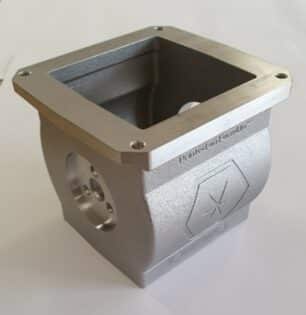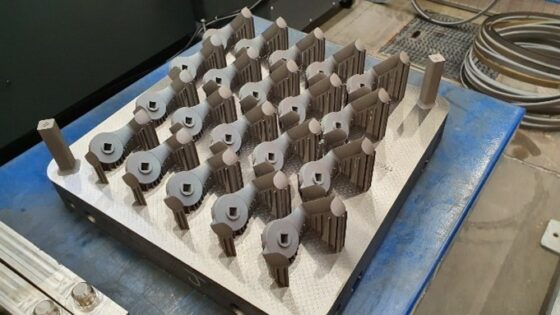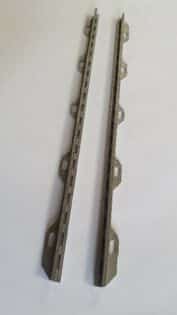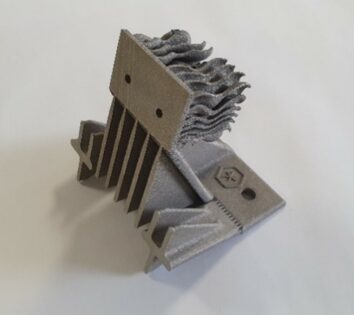AddUp, a manufacturer of metal 3D printers, not only offers parts production services but also utilizes its own machines to manufacture components for their 3D printers.
AddUp is a manufacturer of metal 3D printers that operates its own machines in its workshops to offer parts production services to its customers. But did you know that these workshops are also used to manufacture components to be used on our 3D printers? The FormUp 350 has numerous 3D printed parts, which are representative of the different possibilities offered by the technology.
Parts produced on the FormUp350 for the FormUp 350

Dosing hopper
AddUp is one of the only manufacturers of metal 3D printers to also offer parts production services, thanks to several workshops in Europe and the United States. When not being used to produce parts for customers, FormUp machines make parts for new FormUp machines. “Generating value through parts that combine multiple functions, have better performance or have shorter lead times is not just a speech we make to our customers. It’s also a virtuous circle that we apply internally,” says Léopold Barry, second-generation FormUp 350 project manager at AddUp. “All these developments aim to make this machine a showcase of the different possibilities offered by 3D printing.”

Hopper mixers
Many parts of this machine are made by additive manufacturing, starting with the powder supply system which alone has four printed components. First, the dosing hoppers. These are powder tanks that prevent any interruption in the powder supply to the manufacturing chamber. The design of these parts has been adapted to be made either in a foundry or additive manufacturing to meet short supply time requirements.
Inside these dosing hoppers, there is a part that is also 3D printed. This part is responsible for keeping the powder in motion to avoid any agglomeration that could interrupt production. For this part with complex geometry, additive manufacturing is ideal. On the FormUp 350 x 350 mm build plate, we can print about twenty of these parts at a time, helping to build up stocks of spare parts when needed.

Housing for dosing screws
Just below the dosing hoppers are the dosing screws, which deposit the powder precisely and uniformly on the surface of the “drawers” that transport the powder in front of the layering device. These dosing screws are installed in a sleeve, which is also 3D printed. “This system, printed in a single operation, presents an interesting alternative to its foundry equivalent, as it allows us to quickly test new designs without additional costs related to developing injection molds. In addition, this one-piece part no longer requires assembly operations and has better sealing,” comments Léopold Barry.

Sleeves
Another essential element of the powder supply system is the rails on which the drawers responsible for bringing the powder is guided into the manufacturing chamber. They are also manufactured on FormUp machines in AddUp workshops. The advantage here is the autonomy gained on the management of this part, with supply times shortened as much as possible because the printing as well as the machining are carried out in-house.
Topology optimization and functions integration

While AddUp engineers are able to use additive manufacturing for the powder supply system, which is one of the key functions of the machine, they did the same for some simpler parts as well, such as camera mounts. On FormUp 350, both cameras are installed on printed brackets. First, the image-taking camera, which takes pictures of the end of melting and the end of powder spreading, is placed on support designed with topology optimization. This technique consists of using simulation software that automatically generates an optimal shape for the part, using the quantity of material just necessary to ensure the positioning function of the camera.

Second, the video camera mount was designed using another possibility offered by 3D printing: the integration of functions. “During the development of this machine, our teams worked on the cooling management of the video camera, which is placed above the manufacturing enclosure,” explains Leopold Barry. We designed a new version of this mount, which integrates both the function of holding the camera in position and the cooling function.” The latter function is provided by metal blades that act as a radiator. Their surface, impossible to achieve by conventional techniques, has a large exchange surface with the ambient air and avoids any overheating of the camera.
Parts for series machines, but also for prototypes

Hydraulic block
AddUp is also able to take advantage of the possibilities offered by additive manufacturing at all stages of the development of its new machine, including during the prototyping phases. This provided an opportunity to test a new type of hydraulic block. This part, responsible for distributing the coolant fluid in the machine, was the subject of a complete redesign study. What used to be an imposing piece of raw metal pierced by rectilinear channels has become an optimized system, thanks to its mass reduction and the management of fluids inside the channels. Work is still under way to further improve this part before integrating it into production machines. But, in the meantime, the work on this hydraulic block and the tests carried out under real operating conditions serve as a demonstrator for manufacturers in other sectors facing mass reduction requirements on similar systems.

Door handle
Lastly, a 3D printed door handle for the FormUp is a perfect way for this machine to display its DNA, proving that it is “designed for additive manufacturing, with additive manufacturing.”
AddUp is proud to source our own components using our additive technology. The FormUp 350 truly is designed for additive manufacturing WITH additive manufacturing! Our engineers will continue to explore opportunities to exploit 3D printing and improve AddUp 3D printing machines!
